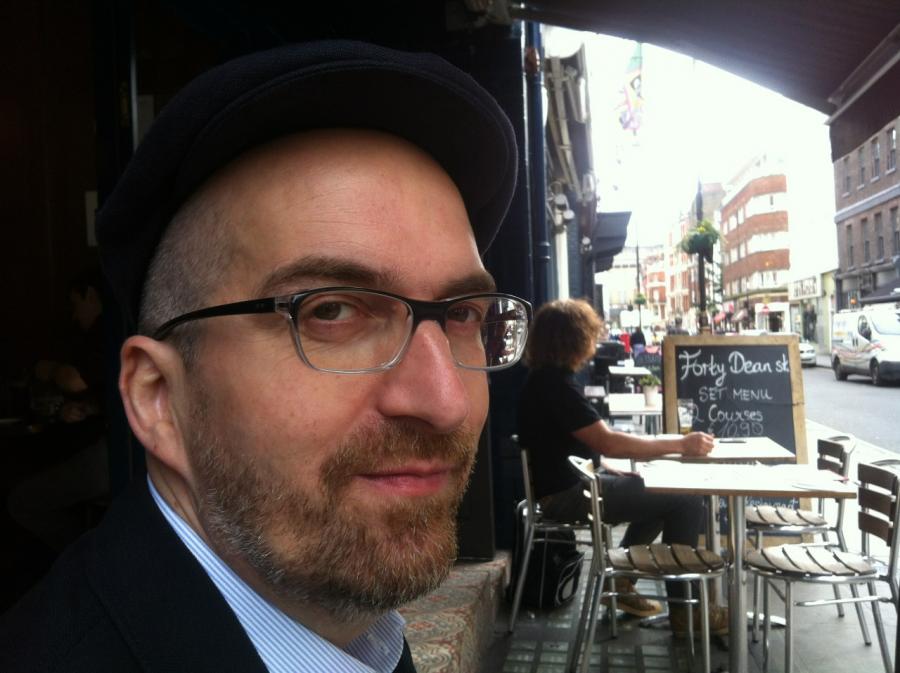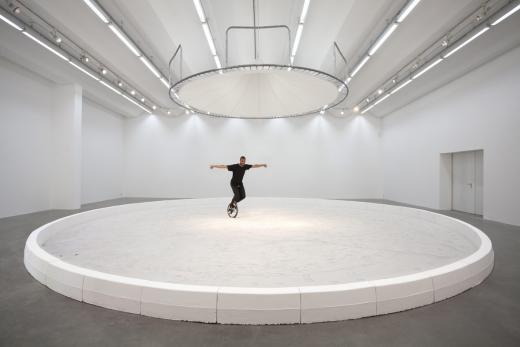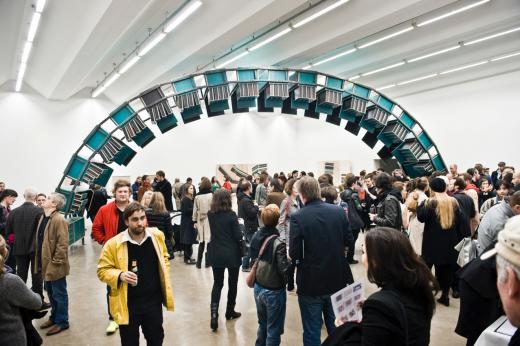Have you met... Jan-Philipp Sexauer
Have you met... Jan-Philipp Sexauer

Formerly mainly industrial surrounding of Weissensee on the border of Prenzlauer Berg emerged in recent years as an appealing area for artists and craftsmen. The abandoned factories have been turned into studios and workshops, with lots of free space in-between and no rules that normally apply among the residential buildings. In one of the spacious industrial halls situated in this unrestricted area, Jan-Philipp Sexauer found the perfect conditions to open his own exhibition space. Sexauer Gallery was officially inaugurated with the first Berlin solo exhibition of works by Jay Gard in October 2013, and has since then hosted numerous exhibitions by known and emerging contemporary art figures.
Prior to opening his own gallery, Sexauer has been organising private cultural events, as well as public exhibitions with artists such as Gregor Hildebrandt, Norbert Bisky, Jonathan Meese, and many others. For the past three years his name became synonymous for a gallery known for its off-the-grid location worth reaching for always excellent shows. Our most recent visit was a special one, as we had the pleasure to meet Jan-Philipp and have a chat about the gallery.
How did it all begin with Sexauer Gallery, and why exactly here in this location?
First I looked for spaces near Potsdamer Straße. I knew about this space before, but at first I thought it might be too risky to do it here. But then after I saw some other spaces, I realized that there won’t be such a great place in Mitte or in Potsdamer Straße that would be so perfect. And then I thought why not; for a gallery you don’t need tourists coming in. People who are really interested will come. I think it was the right decision. I couldn’t have known this before. I just tried it, and now it works.
Does the area have any influence on your work?
Well not directly. But some things that wouldn’t be possible in other places are possible here. This show, for example. We had a circus performance here in the gallery. You couldn’t do this in Potsdamer Straße with all the cars. I have a lot of freedom here with no real neighbors. I can do what I want. The owner of the whole space is an artist too, so he understands these things. I had a performance where Fabian Knecht drilled into the white cube the whole night. A lot of things are possible here.
Would you say the location has a positive influence then?
Yes, because in a way it’s calm. It has a lot of space, and in a way I’m totally free. This might change in the next years, though. For example, they are building a house here. But for now, the whole block between Streustraße and Lehderstrasse, there are no apartments, it’s all atelier studios and workshops.
What is you curatorial strategy here?
I would say the focus is on young artists. One strategy is to really give them the space to do anything they want. Especially if you see the shows of Jay Gard; he really built up big architecture. Or for example Jeewi Lee with this one big installation. I think it is important that they can work nearly like in a museum, and really do what they want. But I will also work with more well-known artists in the future.

Jeewi Lee, "Blinder Beifall". 3 June – 16 July 2016. Photo © Jeewi Lee, Sexauer Gallery
How do you choose the artists and develop the program?
I think that's a very complex process. I'm not limiting to one medium. I have photography, painting, installation... I like the wide range. For example, I have two artists working mostly with photography – Ornella Fieres and Gerrit Engel – and they really show the range of photography. Gerrit Engel is high-end analog, more documentary photography. Ornella Fieres is playing with digital and analog, where it's not about the perfect photography, but about playing with the medium. I like to show with this how many things are possible. The funny thing is that in the end you find a lot of analogies and similarities in works that seem to be very far away from each other. In the end you notice that they work on the same question. That’s what is fascinating for me.
What interests you personally the most, or what inspires you the most in your curatorial activities?
I try to understand and feel what the artist does. For me it is important that it is consistent. I don't think about art as good or bad, and it doesn’t make sense to just judge it from the outside. There are a lot of ways to deal with art and to make art, and I don’t want to decide what is the right way. You have to understand what are the premises, and then you can see if it's consistent. I like works which are more conceptual. If a work is conceptual, I like if it still has something aesthetic. I want to know whether an artist has to express something, and whether an artist wants to analyze something. You can do this with pure thinking, you can do this with writing. But if the artist makes something you can see or smell or listen to, I want to know why he uses certain means of expressing himself. I think it's important for the artist to have a lot of freedom, but also “ein roter Faden,” a thread. But I don’t want to think about this so much, because it’s too much of a strategy. There are hundreds of artists, and there are reasons why you choose them, it’s not one strategy. There are things which are quite normal, such as – you want to work with somebody you like. You don’t have to be friends, but normally you don’t have to work with someone you don’t like. This is very banal and a lot of curators wouldn’t probably mention that, but you have to work with artists for years. And there are a lot of other things you might want: to have an international program, to have different approaches, to have men and women... But it’s not strict. In the end the whole program has to work.

Jay Gard. 11 October 2013 – 16 January 2014. Photo © Benjamin Pritzkuleit, Sexauer Gallery
What has your experience in the field taught you so far?
Oh my god. So many things. Well, the interesting thing about a gallery is that it’s a little world, there are a lot of things. In a way it’s a normal business. I’m not the artist. I like to curate and I like to have influence on the aesthetic and the intellectual world, but artists are artists. My work is also to organize a lot of things for them, and to give them the freedom to work in any way they want.
What kind of advice would you give your younger self when you look back on how you started becoming a gallerist? Would you do anything different?
That’s too early to decide. I learn every day, but I don't have a list where I’m like – oh, today I learned this. I think that’s special in a gallery. If something is not perfect, and even if it’s not your fault, you can always influence it, and do it better next time. But how I would do it next time is very hypothetic and very individual. Some people start with 18 or 20 and do a little project space. Others work for years in a big gallery, and then open their own after 10 years. I worked in another field before, and now I’m doing this for less than three years. Now I see the differences between the artists, how they work, what is important, what is not so important... I build my experience. But there is nothing I would say I would do completely different.
What would you say distinguishes your gallery from other galleries in Berlin?
There are some things I do different. For example, galleries often have openings from 18-21h, and then they go for a dinner with 15 or 20 people. I think this wouldn’t be fair here, because if people come to Weissensee, and I really appreciate this, I will make it an open-end event. A lot of people come to see the show and are also happy to meet people, have a beer and talk about the show. Those are some things I make a little bit different.
And also, I think it's the space. Some spaces are big and it’s not easy to fill them. Here it’s big but it still has the human scale. Here you can't hide anything, especially in group shows where you have 15 works and you have to bring them together. It’s different in a solo show – you can say, okay, these two don’t fit in, we don’t take them. In a group show you have to deal with it, and it’s not easy to anticipate it. That’s why curating is very important in this space – you have to really think about it, it really has to come together, both in solo and group shows.
What do you think is most important for succeeding in Berlin’s art and gallery scene?
There are no recipes. It’s important that people trust you, that artists trust you, that your clients trust you. You shouldn’t think too much about this. Try to do your job and make it good. Of course, you have to think about where you want to be in 2 years. You have to make plans. You have to think about which art fairs you want to go to. But you don’t have to think primarily about how to be successful. There are also lucky opportunities. If you read the biographies of artists or gallerists, you find out that you can't plan everything. You have to make good work, you have to be courageous, try new things, not think too much about what other people think, and go your way. But it’s not specifically a gallerist thing. I think it’s with every business. And I also think it’s ambivalent: you have to be courageous, but on the other hand you have to reflect and think about what you could do better. You can look at how other gallerists and museums work, but there isn't a recipe for it.
What are you currently working on, and what are your plans for the next couple of months?
The next show will be a painting show by Philip Grözinger, and after that I will do a smaller group show which is connected with Beuys. Probably there will be no Beuys piece; that wouldn’t be so interesting. The point is to examine what he means for artists today. Beuys is quite a big and complicated name, and his influence is very diffused. The show will feature well-known artists; It's important that they've already found their artistic language and that they have their own oeuvre. I’m really looking forward to the Beuys show which is curated by Philipp Bollmann, with artists like Michael Sailstorfer, Asta Gröting, Jonathan Meese, Erwin Wurm or Rebecca Warren.
And then I will have Carla Chan. She is from Hong Kong, she lives now in Berlin and makes great installations, video and computer art. We’ll see what she will do here. She has ideas but we’ll see if we can make them happen. We don’t have the means of a big museum, but we can do quite a lot of things here.
* * * * *
Sexauer Gallery
Streustr. 90, 13086 Berlin
Tue–Sat 13.00–18.00 h
More info on the website
Next show:
Philip Grözinger, "From here to now and back again"
Opening: September 9, 18h
Ongoing until October 7
More info